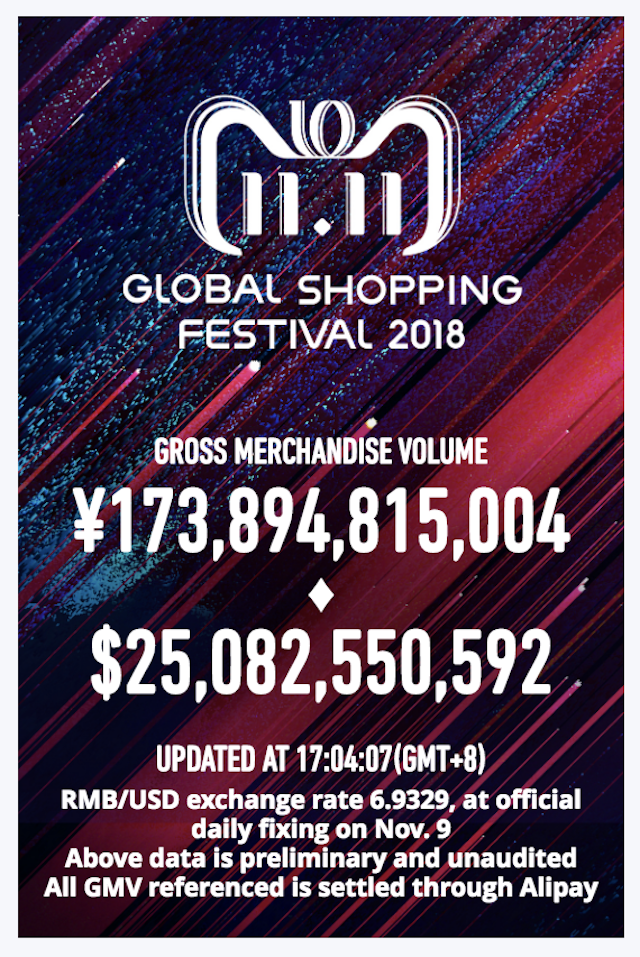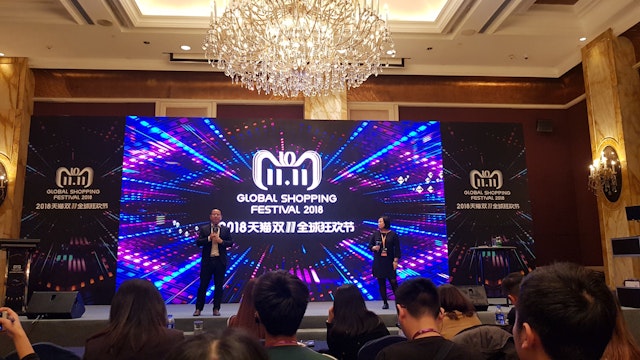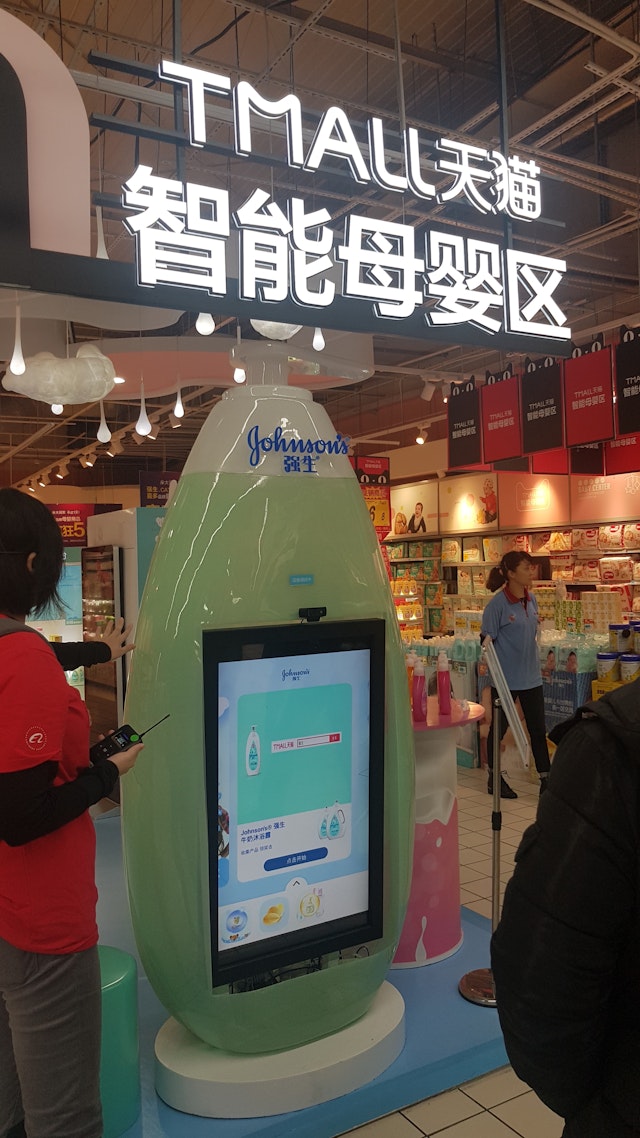The Olympics for brands: why marketers are joining the 11.11 race
This year, as Alibaba celebrates 10 years of 11.11, over 18,000 international brands from over 74 countries are joining Chinese brands in the race to win the hearts and cash of the Chinese consumer.
The scale of this event means Alibaba, the business that launched 11.11 (previously better known as Single’s Day), calls the event the ‘Olympics for brands’ internally. At the time of publishing, with just over six hours to go until the end of the sale, people from across the globe had bought over $25bn in goods from one of Alibaba’s websites. To compare, 2017 was a record year for the West's annual sales day Black Friday and that only hit $7.9bn in total.

This is enticing for any brand, but it also affords businesses a marketing opportunity, to break into a lucrative audience of shoppers. Tmall, one of the key e-commerce platforms under the Alibaba umbrella, runs a business called Tmall Global that helps brands from around the world sell to the Chinese consumer. Yi Qian, deputy general manager of Tmall Global, said 46% of the platform’s users are the new middle class and over 50% are young millennials, two key demographics for many major brands.
Speaking during the event, he said that many foreign brands were now established enough that they were taking their partnership with Alibaba to the next level. “They are now developing products for Chinese consumers. What happens now is that these brands focus on the consumer and change the product accordingly. Once the brands are established, then they become more localized.”

During the event Alibaba also used the opportunity to update the market on its Tmall Innovation Centre (TMIC), a business unit that fuses technology and data from its platform with research and development, to help brands find new products and strategies.
Duan Ling, head of Tmall Innovation Center, said: “We have launched 330 new products which we then trace the performance of on the Tmall platform. When we create new products, there is a six-month incubation time. Versus the old time, it is around half the time because the efficiency is higher. It is also more accurate. Our data shows that 70% of products become a top seller within its segment, compared with offline where the success rate is only 5%”
She used the example of Mars, which first worked with Alibaba to find a new flavor for Snickers. The result was a ‘spicy’ flavor. From that, it moved onto the Dove range of chocolate, for which Alibaba found an insight around gifting and e-commerce. The businesses created a personalized box that sold out on day one of launch.
But the competition is high, even for Alibaba, because the scale of this event and the habit it’s created on this date, means that it’s now competing against a myriad of other e-commerce brands.
To find out more about why brands see value in participating in sales events like 11.11, and whether it can stand the test of time, the Drum spoke to experts across the world.
Xiaofeng Wang, senior analyst, Forrester
Festivals are great opportunities for marketing and promotions. Brands have been leveraging all types of festivals to engage with consumers and boost their sales, including traditional holidays like Mothers’ Day, Christmas; and other traditional shopping festivals like Black Friday and the Great Singapore Sale. Singles’ Day provides brands with another opportunity for marketing and promotions. It started online but has now extended to offline.
Giulio Xiloyannis, chief operating officer, Zalora
Singles' Day is now nearly four times larger than Black Friday and Cyber Monday, the two biggest shopping days in the US, making it the world’s biggest online sales event. In 2017, Chinese customers nearly doubled their spend on 11.11, reaching previous year full day sales in ~13 hours. Shoppers spent more than $25bn (168.2bn yuan) on Singles Day 2017, smashing previous records for the world’s largest retail event. The effect of 11.11 created ripples across the region, and now Southeast Asia-based e-commerce sites are also benefiting from the mega sale event.
The commercial value of huge campaigns such as these comes from collective action. When more retailers join in, it creates an exponential marketing effect and increases awareness for everyone.
Building brand awareness and reaching new customers are two of the most immediate opportunities brands have when they participate in Single’s Day event. The number of consumers looking for great deals significantly increases during this period with a high conversion from eyeball to purchase. Another benefit of Single’s Day is it gives brands the ability to test an offer. If a sale does well on Single’s Day, the advertiser can re-use it or calibrate it slightly to appeal to a wider audience in the future. More importantly for young e-commerce markets, it’s an opportunity to convert traditional consumers into e-consumers.
Moreover, and particularly in fashion, 11.11 is not just about great discounts and price action, the event is big enough to have become the ideal platform for limited edition launches and special collections. A good portion of the products we will be offering for 11.11 is only going live on the eve of the day itself as collections specially designed for the event and for the days surrounding the event.
11.11 is allowing brands to not just test promotion mechanics and increase awareness, but also test new product launches altogether.
Zhou Junjie, chief commercial officer, Shopee
11.11 has evolved to be the largest shopping day in the world, with bigger promotions and discounts every year from brands worldwide. No longer just a day for singles or a day about China; today it is widely reported that sales from 11.11 exceed the combined sales from festivals such as Black Friday and Cyber Monday.
Brands understand that festivals like the recent Shopee 9.9 Super Shopping Day and ongoing Shopee 11.11 Big Sale are a huge opportunity for exposure as they draw huge crowds of shoppers annually.
Deborah Chong, head of e-commerce South East Asia, Reckitt Benckiser Home & Hygiene
These festivals are a great opportunity for us to showcase our product offerings, engage shoppers and foster brand loyalty. Our sales expectations were exceeded during the recent Shopee 9.9 Super Shopping day, where we saw a 4x increase in orders compared to last year.
Donovan Kik, vice president of segment and marketing, StarHub
Singles’ Day is held exclusively online which gives us the opportunity to engage the ever-growing number of online shoppers here. In terms of execution, the online nature of Singles’ Day also lets us try something different with Michelle Chong (as “Premium Lian”) fronting our hyperlocal social media campaign.
The campaign is a tongue in cheek homage to the recent trend of online shops selling items on Facebook Live so there is definitely a strong element of fun. At the end of the day, we want customers to feel that they got a great deal and were entertained at the same time.
How does e-commerce platforms like Lazada, Taobao, Shopee etc help brands ensure there is no shoppers’ fatigue?
Candice Ong, chief commercial officer, ShopBack
The idea of a festival, hyped up with a slew of entertainment factors, help to keep fatigue at bay. This trend probably began when Alibaba brought global A-list celebrities to their TV special in 2015 to welcome the dawn of 11.11. Mini-games with shakes and slashes help to double down on shoppers' engagement as well.
Patrick Smallcombe, president, South East Asia at Johnson & Johnson
Johnson & Johnson is pleased to partner Lazada (owned by Alibaba), where we are present on LazMall across all six markets (Indonesia, Thailand, Singapore, Malaysia, Philippines, Vietnam) in Southeast Asia for the biggest ever 1-Day 11.11 Shopping Festival.
With e-commerce as one of our prioritized growth drivers in the organization, the collaborative partnership and expertise from Lazada help support our FMCG brands to more effectively extend customer experiences beyond just online shopping; and to understand more quickly what customers want through a connected commerce approach.
Today, as the world’s largest and most broadly-based healthcare company, Johnson & Johnson believes unlocking and accelerating eCommerce potential also provide us with the opportunity to play a bigger role to reach out more directly to our customers, patients and consumers to provide more accessible, affordable and locally relevant products and solutions. My heartiest congratulations to Lazada on the official kick-off of their 11.11 Shopping Festival!

Donovan Kik, vice president of segment and marketing, StarHub
While there is potential for shoppers’ fatigue, this risk can be countered by having a good grasp of consumers’ preferences and a well-planned marketing calendar. In addition, we adopt an omnichannel approach so we have the option of running targeted promotions, be it through our StarHub Shops, online store or direct marketing.
Supriya Jain, managing director of Lion & Lion in Hong Kong
E-commerce giants facilitate a larger variety of products with a larger spectrum of discounts. This is no longer a playing field for ‘flat discounts’ or simple incentives. Early bird offers start as early as 1st November to capture consumers attention during the run-up to the big sale on 11.11. As an example, Tao Bao provides innovative discount mechanisms like click and collect vouchers, pre-order, and red envelopes to drive up the ticket size of the transaction, and thus they ensure they engage customers. Likewise, Lazada offers daily giveaways, social contests, and bumper prizes to encourage shoppers to shop and share their experience on social media.
Mimrah Mahmood, regional director for Media Solutions, Meltwater APAC
Shoppers’ fatigue occurs when brands are pushing out repetitive content over extended periods of time – this can refer to both the product mix and the way commercial messages are disseminated. Given the digital nature of e-commerce platforms, it is not surprising that we are observing so much commercial push happening on social media.
To make promotional messaging palatable for consumers, it is imperative that they come across as authentic and as relevant to the target audience as possible. A great example of how e-commerce platforms are ensuring a good mix of content is to engage several core influencers, supported by a variety of micro-influencers, reaching even into a niche and previously untapped audiences via organic reach.
While most companies spend a lot more in paid search (SEO) and banner ads than they do in social optimization, it is also interesting to observe how social traffic is comparable to the traffic generated through these tactics. According to Meltwater data, 5% of Lazada Malaysia’s traffic was attributed to social media while paid searches generated 6.6%. On the other hand, Shopee Singapore generated 4% traffic through social and 5.9% through paid searches.
Tom Blackman, director of Asia, Zendesk
Requests for customer support surge dramatically during peak shopping periods – in both pre- and post-purchase – as much as 42%. This sudden spike in sales volume combined with the need for customer support agents to manage multiple channels often leads to delays in expected response times and a decline in customer satisfaction. Coupled with heightened expectations to get purchases before key festive dates, the peak shopping periods become a perfect storm for frustrated shoppers.
A key challenge for brands is to anticipate this influx and put in place systems and processes in advance to help ensure customers can access support independently using a help center while empowering customer support agents to provide swift and satisfactory resolutions to more complex queries.
Should brands worry that it cannibalize existing sales? Example, people paying lesser online.
Xiaofeng Wang, senior analyst, Forrester
More and more brands and retailers are embracing an omnichannel strategy. An important part of omnichannel is product and price parity. The ultimate goal is to provide consistent customer experience across channels and platforms. If brands don’t provide price parity, eventually they’ll lose consumers to competitors who can provide better customer experience. After all, it’s the age of the customer.
Additional reporting by Shawn Lim, reporter, APAC
Content created with:

Alibaba
Alibaba Group Holding Limited is a Chinese multinational e-commerce, retail, Internet, AI and technology conglomerate founded in 1999.
Find out more
